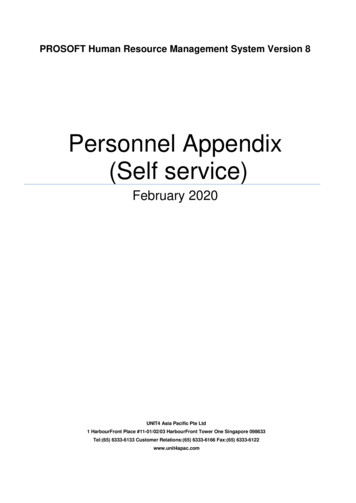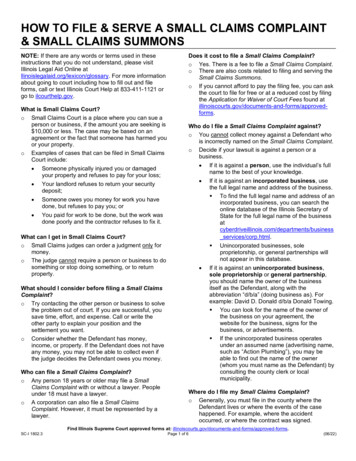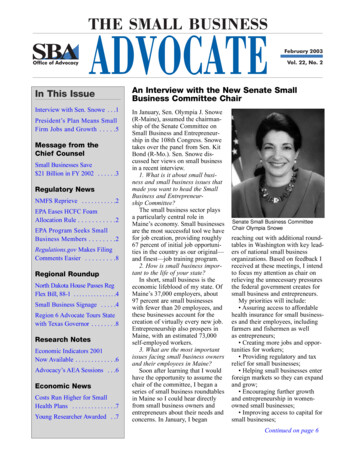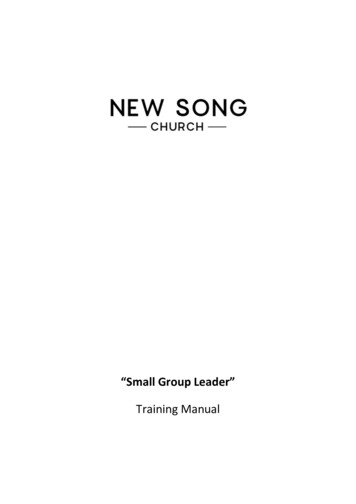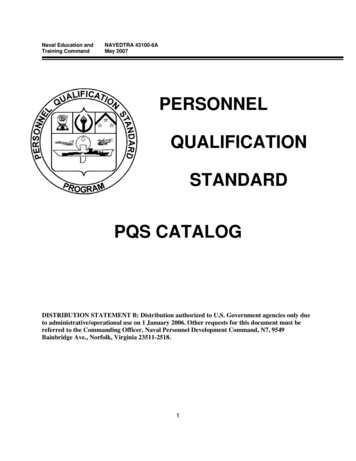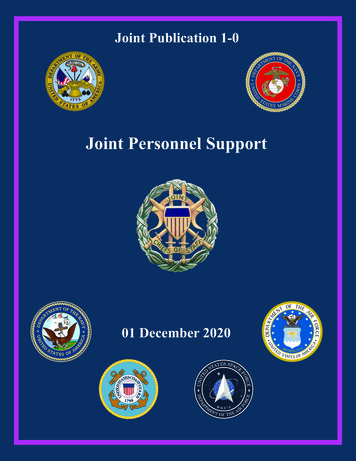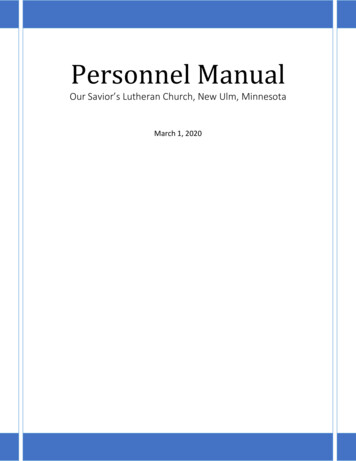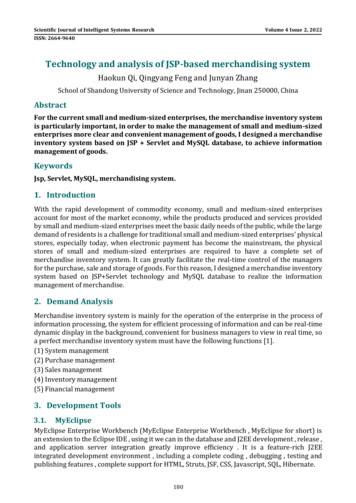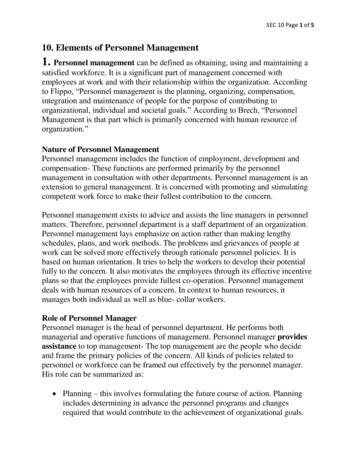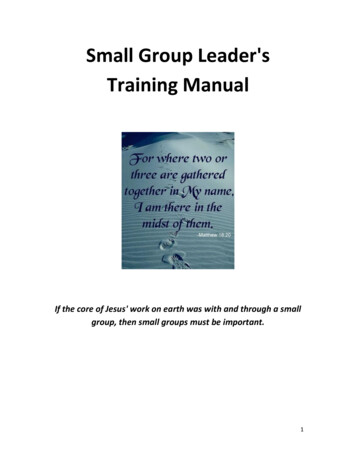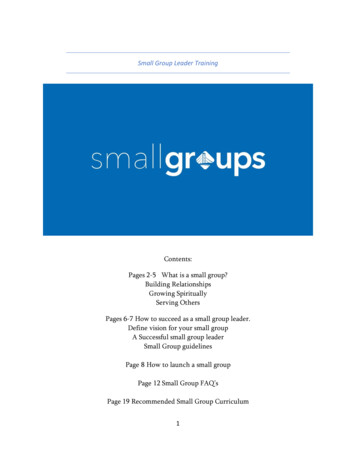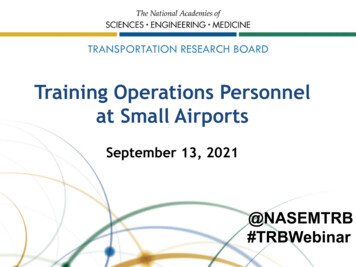
Transcription
TRANSPORTATION RESEARCH BOARDTraining Operations Personnelat Small AirportsSeptember 13, 2021@NASEMTRB#TRBWebinar
Learning Objectives1. Discuss training methodologies2. Describe all aspects of training, includingstyles, motivations, curriculum design,training topics, methods, and budgets
American Association of AirportExecutives (AAAE)1.0 Continuing Education Units (CEUs) are available toAccredited Airport Executives (A.A.E.)Report your CEUs: www.aaae.org/ceu
Questions and Answers Please type yourquestions into yourwebinar control panel We will read yourquestions out loud, andanswer as many astime allows
Adam WolfThe Ohio State University Airport OSU Airport -Airport Director. Embry-Riddle Aeronautical University-2006.BS Aeronautics, Minors in Aviation Business,Aviation Safety and Meteorologically AAAE- CM, ACE Ops, ACE Security Private Pilot w/Instrument Rating UAS 107 Operator Certified Weather Observer Previous Experience CMH – Airport Operations PANYNJ- Airport Operations andFinance roles
Five Ways to Get Involved!Visit us online:www.trb.org/ACRP
Theresia SchatzACRP Senior Program OfficerACRP Seeking Synthesis Topics for the Fiscal Year 2022Submission ideas are due byMonday, September 27, 2021Sign in to IdeaHub using your MyACRP login https://ideahub.trb.org/
Today’s SpeakersDr. Daniel Prather, DPrather Aviation SolutionsandJoseph Goetz, Quad Cities International AirportPresentingACRP Synthesis 112: Airport OperationsTraining at Small Airports
ACRP Synthesis 112Airport Operations Trainingat Small AirportsC. Daniel Prather, Ph.D., D.B.A., A.A.E., CAMDPrather Aviation SolutionsCalifornia Baptist UniversityJoseph Goetz C.M., A.C.E.Quad Cities International Airport
C. Daniel Prather, Ph.D., D.B.A., A.A.E., CAMPrincipal Investigator Consultant DPrather Aviation Solutions Founder PDPCredit.com Professor California Baptist University Former Assistant Director of Operations Hillsborough County AviationAuthority (TPA) Accredited Airport Executive (AAAE) Certified Aviation Manager (NBAA)
Joseph Goetz C.M., A.C.E.Airport Operations Manager (Case Example) 2010-2016 Bellingham International Airport Operations/ARFF 2016-2020 Crater Lake – Klamath Regional Airport Airport Operations Manager 2020-Current Quad Cities International Airport Airport Operations Manager Certified Member Airport Security Coordinator A.C.E. – Operations A.C.E. - Security
ACRP Synthesis 112 Topic Panel Scott Ayers, City of Atlanta Department of Aviation, Atlanta, GAKimberly A. Kenville, University of North Dakota, Grand Forks, NDHarleen Smith, City of Houston–Houston Airport System, Houston, TXLauren Tapia, Truckee Tahoe Airport, Truckee, CAAshly “Jerry” Tissera, JTA Consulting LLC, Aston, PAAdam Wolf, Ohio State University Airport, Columbus, OHDale A. Williams, FAA LiaisonChristopher J. Oswald, Airports Council International–North America Liaison
Learning Objectives Understand challenges related to airport operationstraining. Interpret project results. Understand airport case examples, including innovativeapproaches that may be adopted by your airport. Formulate action steps from findings.
Introduction Perennial challenges of efficiently training airportoperations personnel to ensure a safe and secure airport. Limited resources.Need for standardization.Employee turnover.Lack of designated trainer.Boring content.Disengaged employees.Initial and recurrent training.
Methodology
ApproachSurvey(182)
Approach
LITERATURE REVIEW
Topics Included Adult learning stylesLearner motivationGeneral learning preferencesInitial and recurrent trainingProfessional developmentTraining needs assessmentTraining curriculum designTraining materialsTraining manual
Topics Included Training budgetsTraining timelinesBenefits and disadvantages of trainingTraining methodsTraining recordsTrainer qualificationsTraining assessmentProof of training competency and completion
Baby Boomers (born 1946-1964)Train: Use facilitated, instructor-led learning with handouts.Examples: Lecture Detailed handouts Note-taking Personal stories related to content
Generation X (born 1965-1980)Train: Include games and case studies with real-world feel.Provide clear instructions. Explain how training benefitsthem.Examples: Distance learning Self-paced and independent instruction Detached study guides and test reviews
Millennials (born 1981-2000)Train: Highly visual and expect technology to be integrated withlearning. With short attention spans, they benefit from bitesized learning.Examples: Simulations with immediate feedback Group activities include problem solving Creative interactive exercises (i.e., Jeopardy-style teamgames)
Generation Z (born after 2000)Train: Benefit from taking part in the training process, to includerole playing, creating videos, and integrating social media.Short attention spans ad very accustomed to digitalexploration and training methods.Examples: Computer-based training Online courses Opportunity to search intent for answers
RESULTS
Average Airport Training BudgetNPIASCategoryLowAverageHighLarge hub 9,000 220,583 1,500,000Medium Hub 3,000 26,700 60,000Small hub 2,500 20,926 70,000Nonhub 500 13,168 150,000Nonprimary0 833 1,500Reliever0 4,000 12,500GA0 13,278 200,000
Training Methods - Small Airports
Sources of Initial Training - Small Airports
Sources of Recurrent Training - Small Airports
Training Topics1. Airfield self-inspections2. Airfield familiarization3. Wildlife hazard management4. Airport emergency plan5. Movement area6. Airfield nightly inspections7. Aeronautical radio procedures8. Airport rules or regulations9. NOTAMs10. Airport standard operating procedures
Training those without experience
Training those with experience
CASE EXAMPLES
Case AirportWichitaNational AirportFortLauderdaleHollywood IntlAirportSizePracticeMed hub 6-weektrainingprogramWichita, KS le, hubbasedFLlearning
Case AirportLocationAirport PracticeSize4Greer, ortGainesvilleRegionalAirportDallas-FortWorth IntlAirportProprietarylearningmgt systemGainesville, Nonhub Visit to peerFLairportsDFWAirport, TXLargehubLive ATCand driversimulator
Case AirportLocation AirportSizePractice7Charles B.WheelerDowntownAirportKansasCity, MO8OregonDept ofAviationSalem, OR GAOpspresentations,identify animalremains, Part139 quiz showChallengesand need fortraining toolsReliever
Case AirportLocationAirportSize9BrooksvilleTampa BayRegionalAirportBrooksville, GAFL10South Bend Intl SouthAirportBend, exchangeprogram
Case Airport111213Location Airport PracticeSizeAspen-Pitkin Aspen, CO Nonhub n BayGreen Bay, Nonhub LearningIntl AirportWIstyles basedadaptivetrainingOhio StateColumbus, Reliever UAS useUniversityOHAirport
Airport Case Example:Crater-Lake Klamath RegionalAirportMr. Joseph Goetz C.M., A.C.E.
Alternate Methods for Completing Recurrent Training What are we trying to accomplish? Engaging all learning styles (auditory, visual, kinesthetic)Making repetitive training funRetention of learned materialProof of training’s effectivenessNot just another slideshow Alternate methods JeopardyScavenger HuntTraining Worksheets/QuizzesIncentives
Runways&TaxiwaysAirside s and G.A.
Question 3 - 30 What type of aircraft arresting systems are installed onRWY 14/32 and how far down the runway are theylocated?
Question 4 - 10 The easiest way to find the boundaries for airportproperty would be to look at this.
Airport Familiarization Scavenger Hunt
Airport Familiarization Scavenger HuntLocation 2 Questions1. What is the full name of the organization that owns thisproperty?2. What is the specific purpose the organization uses this propertyfor?3. Please describe any tasks that airport personnel mayundertake on or adjacent to this property.
Training Worksheets
Training Worksheets
Training Worksheets
Actionable Findings
Actionable Findings1. The development of training curricula, methods, timelines,etc. is best accomplished from the employees’ perspective.2. Employees benefit from receiving a certain minimumduration of training and then receiving additional trainingtime as necessary to build required proficiency andknowledge levels.
Actionable Findings3. Conduct a training needs assessment for both employeesand the airport.4. Airport trainers benefit from a knowledge of individuallearning styles and adult teaching methods.5. Asking employees to complete a learning styles inventory orassessment will enlighten trainers as to the preferredlearning styles of employees.
Actionable Findings6. Employees benefit most when presented with engagingcontent that is easily accessible and meets all three learningstyles (visual, auditory, and kinesthetic).7. Prioritize training with a sufficient budget.8. Having dedicated resources in the form of a dedicatedtraining department, even if staffed by only one individual, isan option to be considered.
Actionable Findings9. Airports may consider additional sources of training, toinclude products offered by AAAE and ACI–NA, as well asteam teaching with peer airports and mutual aid agencies.10. Although a significant portion of current operations trainingis conducted on the job, combining other methods can resultin better employee learning and engagement.
Actionable Findings11. PowerPoint presentations are not innovative: they generallydo not engage learners, and they tend to be viewedunfavorably by students.12. Consider the learner and develop a training program basedon a needs assessment.
Appendices Included in ReportA. Several Sample Operations Employee Training ChecklistsB. Sample Airport Operations Center Training ChecklistC. Sample Badging Training Checklist
Conclusion Each airport must determine training approaches that workwell, considering training environment, budget, employeeexperience, and training objectives. There is no “one bestway.” Innovative training approaches are just that – innovative.But employees deserve innovative training! Focus on your most important resource!
FOR ADDITIONAL INFORMATIONDr. Daniel Prather, A.A.E., CAMdaniel@dprather.comMr. Joseph Goetz C.M., A.C.E.jgoetz@qcairport.com
ACRP is an Industry–Driven Program Managed by TRB and sponsored by theFederal Aviation Administration (FAA). Seeks out the latest issues facing the airportindustry. Conducts research to find solutions. Publishes and disseminates research resultsthrough free publications and webinars.
Other Ways to ParticipateBecome an Ambassador. Ambassadors represent ACRP atevents and conferences across the country!Sponsor or become an ACRP Champion. The championprogram is designed to help early- to mid-career, youngprofessionals grow and excel within the airport industry.Visit ACRP’s Impacts on Practice webpage to submit leadson how ACRP’s research is being applied at any airport.
Other ACRP Research on Today’s TopicResearch Report 16:Research Report 103:Synthesis 78:Synthesis 94:Web-Only Document 28:
ACRP Seeking Synthesis TopicsHave an important topic you’d like to see addressed in anACRP Synthesis?Submission of potential topics through IdeaHub are duebyMonday, September 27, 2021https://ideahub.trb.org/
ACRP Photo Contest:Is your airport photogenic?Submit a photo for the ACRP Annual Report!Due September 22, 2021https://bit.ly/ACRPPhotoContestPhoto courtesy of David Rosenblum, Philadelphia International Airport
Upcoming ACRP WebinarsSeptember 29, 2021Implementing Airport Public-Private PartnershipsOctober 12, 2021Attention Employers! Cultivating Talent in the Airport EnvironmentOctober 18, 2021That’s the Ticket! Evaluating Traveler Perspectives
Subscribe to the newsletter for the mostrecent TRB news & research! Even previous subscribers count/TRBWeekly
Get Involved with TRB#TRBwebinarGetting involved is free!Be a Friend of a Committee bit.ly/TRBcommittees– Networking opportunities– May provide a path to Standing Committee membershipJoin a Standing Committee bit.ly/TRBstandingcommitteeWork with CRP https://bit.ly/TRB-crpUpdate your information www.mytrb.org
1.0 Continuing Education Units (CEUs) are available to Accredited Airport Executives (A.A.E.) Report your CEUs: . GA; 0. 13,278; 200,000. Training Methods - Small Airports . Gainesville Regional Airport. Gainesville, FL. Nonhub. Visit to peer airports. 6. Dallas-Fort Worth Intl
